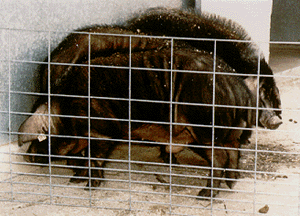Minzhu Swine
 The Minzhu breed was introduced into the United States through a joint effort of the
USDA, the University of Illinois, and Iowa State University. This effort was also
successful in introducing Meishan and Fengjing pigs from China. This effort introduced a total of 144 pigs from these breeds into
the United States. Iowa State University received 7 Minzhu males from this shipment
on July 27, 1989.
The Minzhu breed was introduced into the United States through a joint effort of the
USDA, the University of Illinois, and Iowa State University. This effort was also
successful in introducing Meishan and Fengjing pigs from China. This effort introduced a total of 144 pigs from these breeds into
the United States. Iowa State University received 7 Minzhu males from this shipment
on July 27, 1989.
Minzhu pigs come from far northern China. They can be found in the Middle Temperate Belt, to the north of the Huaihe River Basin and the Qinling Mountains. The cold and dry climate of this region makes the Minzhu very tolerant to cold temperatures and harsh feeding conditions. They are also known as the Ming, Min, or Da Min. Minzhu is said to mean "folk pig."
The Minzhu breed can be identified by its very long black hair. This hair has coarse, long bristles and a dense woolen undercoat in the winter. This hair allows sows to farrow in an open shed at 4° C with no problems. The body size of this breed is relatively large, with a narrow, level back and loin. Minzhu pigs are able to store 4.6 kg of body fat in the abdomen. Sows grow to be about 87.5 cm high, 130 cm around the chest, and 88.3 kg in live-weight. They have a backfat thickness of 3.2 cm and a dressing percentage of 72.2%
It is a prolific breed, though not as prolific as the other breeds imported. They reach puberty at 3-4 months of age, achieve high embryo survival rates, and a large litter rate of 15-16 pigs. Third and later parities of this breed had 15.5 pigs born, with 11.0 being weaned. Their 240 day weight has 233.9 lbs., with an ADG of 1.10 lbs.
References
Information compiled by Marcus Johnson, Freshman Honors Student, working with Paul O. Brackelsberg, Professor of Animal Science, Iowa State University, Ames, from Breeding and Reproduction, ASL-R644.
Article and photographs contributed by Max F. Rothschild, Professor of Animal Science, Iowa State University, Ames.
Further information from FAO Animal Production and Health Paper 46, Livestock Breeds of China, by Cheng Peilieu, Institute of Animal Science, Chinese Academy of Agricultural Sciences, Beijing.
